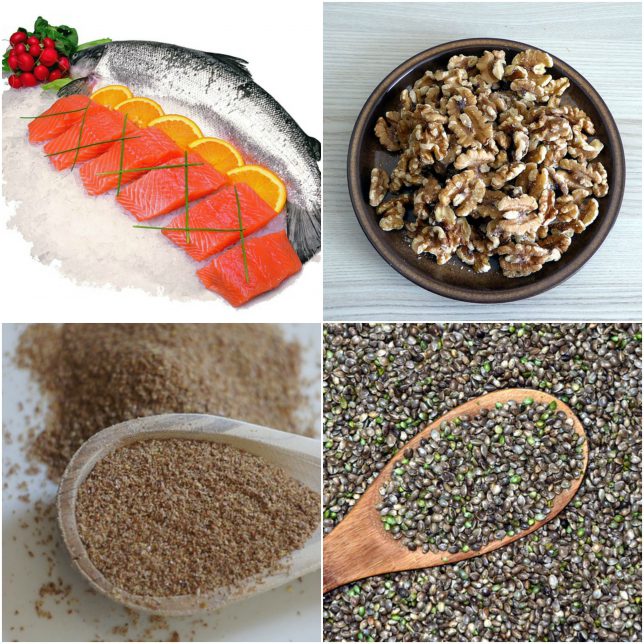As much as we are told that fat is bad for us, essential fatty acids (EFAs) play a vital role in our optimum health. They have been shown to support and improve heart health and inflammation, hormone and immune functions, and decrease the risk of degenerative disease.

Of course, there are fats that can kill you and are associated with heart disease, diabetes, arthritis and cancer that are being consumed daily, including bad saturated fats and hydrogenated fats, and ugly trans fats.
But we’re focusing on the good guys, the ones we need more of in our diet…the unsaturated healthy fats, omega-3, 6 and 9.
Why are EFAs So Essential?
EFAs consist of healthy fats omega-3, 6 and 9. Omega-3s and 6s (polyunsaturated) are essential because the body cannot make them. Omega-9s (monounsaturated) are non-essential because the body can make them from other fatty acids.
More on this in a minute, but it’s important to note that a healthy balance of all omegas is key to optimal health, yet the modern diet is overly abundant in some omega-6s and deficient in omega-3s.
Research has shown EFAs to be necessary for the proper structure and function of every cell in the body. These fats play a key role in increasing the absorption of vitamins and minerals, promoting proper nerve function, healthy hormone production, nourishing skin, hair and nails, and supporting overall normal growth and development, so it’s pretty easy to see how important they are for optimal health.
Why Does the Ratio of Omega-6 to Omega-3 Matter?
If you take away anything from this article, let it be this: the key is to aim for a balanced ratio of omega-6 to omega-3. Why is this so important?
Studies have concluded that while a substantially high omega-6:omega-3 ratio promotes inflammation and the development of many chronic diseases, a reduced omega-6:omega-3 ratio can reduce inflammation and prevent or reverse these diseases.
Most experts conclude that a ratio of 4:1 is ideal for the average person, meaning we should be eating four times as much omega-6 fats as omega-3. But the average American falls somewhere between 12:1 to 25:1… pretty scary. This skewed ratio along with impaired gut health are major contributors to the mass inflammatory diseases we face as a modern nation.
The reason for this is that the western diet consists of high amounts of oils that are high in omega-6 vegetable oils. Oils like corn, soybean, safflower, cottonseed, and sunflower are cheap to produce and used in the bulk of packaged foods.
The stabilization of these oils through hydrogenation to increase shelf life converts them into even more harmful synthetic trans fats. To make matters worse, cooking these oils at high heats, microwaving, or frying oxidizes the fats making them extremely inflammatory and bad for your health. Lack of omega-3s and an abundance of the wrong kind of omega-6s puts you at risk for deficiency in EFAs.
We can learn a lot from hunter-gatherers and non-industrial cultures who had no clue of what omega-6 and 3 fats were and yet managed to stay healthy by eating foods that were available in their natural environment.
Based on various healthy cultures, I’m not sure there is a hard fast ratio of omega-6 to omega-3, but if hunter-gatherers living mostly on land animals ate a ratio of 2:1 to 4:1, cultures living mostly on dairy 1:1 to 2:1, and cultures living mostly on fish and coconuts 1:2 to 1:4, this seems like pretty solid evidence for an ideal range.
One thing is apparent, it’s best to aim for low and balanced ratios of omega-6:omega-3. That being said, let’s look at some whole foods that supply omega-3s and 6s.

Which Foods Provide Which Omega Fatty Acids?
Omega-3s Providing EPA and DHA (lacking in the modern diet)
- cold water fatty fish including salmon, herring, mackerel, trout, sardines, anchovies, tuna, and cod
- omega-3 enriched eggs
- marine algae
Omega-3s Providing ALA (lacking in the modern diet)
- perilla oil, flaxseed oil, chia seeds, and hemp oil
- omega-3 enriched eggs
- some nuts, green leafy vegetables, wheat germ, and black currant seeds contain small amounts
Omega-6 Providing LA (common in the modern diet)
- vegetable oils including safflower, evening primrose seed, sunflower, corn, hemp, pumpkin, peanut, borage, canola, and olive
- nuts/seeds including sunflower (roasted), pine, pecans (roasted), and brazil
Omega-6 Providing GLA (generally not obtained through diet alone)
- plant oils including borage, black currant, and evening primrose
Omega-6 Providing AA (abundant in the food supply and too much can be harmful, leading to potential inflammation and blood clots)
- meat, poultry, and eggs
How Do EFAs Support Health?
- heart health
- hormone function
- nervous system function
- brain and mood health
- healthy inflammation response
- healthy hair, skin, and nails
- joint and bone health
- healthy metabolism and weight
- reduced risk of diabetes and cancer

What are Signs of EFA Deficiency?
Along with modern dietary and lifestyle choices, the effects of environmental pollutants are common reasons for deficiencies in essential fatty acids. Other factors include inefficient conversion of LA and ALA to their by-products that are responsible for hormone production. Stick with me, more on that in a minute :)
Symptoms of omega-3 deficiency can vary in each individual but generally include the following:
- dry scaly skin and other skin problems
- fatigue
- impaired growth and fertility
- neuropathies and other nervous system related problems
- losses in visual acuity
- increased illness
- cell death
- organ damage and failure
Bottom line: Because a constant supply of sufficient EFAs in the diet is needed to maintain cell membrane integrity and function, and to regulate cellular processes and produce hormones, supplementation may be required if the diet is deficient.
See the 5 For You list for how to choose a high-quality fish oil supplement.
Omega-3 Types, Conversions and Absorption
I could devote an entire post to the intricate process of omega conversions in the body, and if you’re a total science buff you can check out a detailed chemistry of fatty acids. The main thing to know is that the structure of omega-3 and omega-6 are two entirely different beasts. Why does this even make a difference in the first place? For non-science buffs I’ll try to break it down into simple terms. Let’s take a closer look.
As I mentioned earlier, essential omega-3s and 6s cannot be made by the body. They can only be derived from the food we eat, or supplements. And while the body can make omega-9s from other fatty acids, it’s not so easy. There needs to be a presence of the other fatty acids in our diet for our body to manufacture omega-9 fatty acids. Otherwise, the only other way to get them is through supplements.
Omega-3 fatty acids consist of three main types:
EPA (eicosapentaenoic acid) and DHA (docosahexaenoic acid) – Long chain omega 3s available from cold water fish and fish oil supplements, some omega-3 enhanced eggs, and grass-fed animals.
ALA (alpha-linolenic acid) – Short chain omega-3s available from plant sources and some omega-3 enriched eggs.
Our body can directly use the fatty acid DHA (docosahexaenoic acid), which is imperative for the nervous system and brain function, including brain development in infants, prevention of depression, stress reduction, eye function, and more.
The fatty acid ALA (Alpha-Linolenic Acid) is not synthesized by humans and is a precursor that the body must convert into the omega-3 fatty acids DHA and EPA, and the conversion is very inefficient. To top it off, the presence of something called the D6D enzyme is required to start the first step in the conversion and there are many factors that can interfere with the conversion including the following:
- a high intake of saturated fat and trans fats
- a high intake of LA (from refined vegetable oils such as corn, canola, soybean, sunflower, safflower)
- some pharmaceutical drugs
- some food additives
- excess alcohol consumption
- smoking
- stress
- aging (enzymes become less effective)
- infant prematurity (D6D enzyme isn’t very efficient until about 6 months old)
- allergy-related eczema
- diabetes
- cancer
- viral infections
Bottom line: You may convert some ALA to DHA but it’s sketchy at best. It’s best to get DHA directly from food sources and supplements, eliminating the need to rely on the metabolic conversion from ALA.
Final Thoughts
By now it’s easy to see that fat villainizing should be a thing of the past. The fact is that not all fats are created equal. It’s also easy to see that the benefits of healthy fats cannot be overstated since a good balance of all the essential fatty acids (EFAs) is absolutely necessary for every cell in the body to be able to function properly for optimal health.
The ideal way to ensure your are receiving enough omegas in your diet is to fill your plate with fatty fish and add nuts and seeds and their oils like flaxseed oil and hemp oil to things like your salads, stir frys, sauces, and smoothies. And if your diet consistently lacks these omega rich foods, supplementation with omega rich oil, including flaxseed oil or fish oil is seriously worth your consideration.
What are some of your favorite sources of healthy fats? Have EFAs improved your health in any way?
